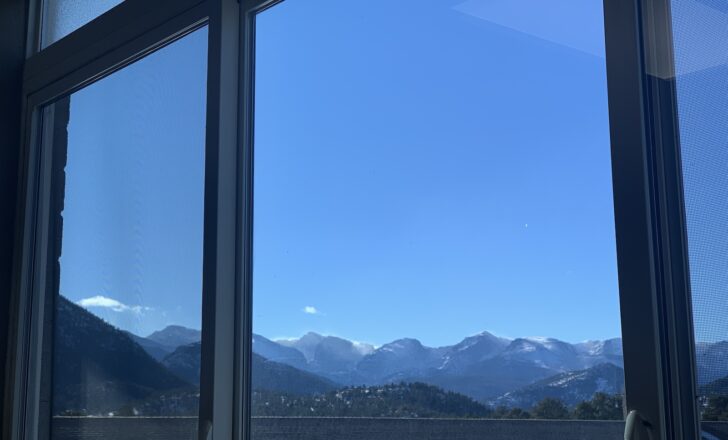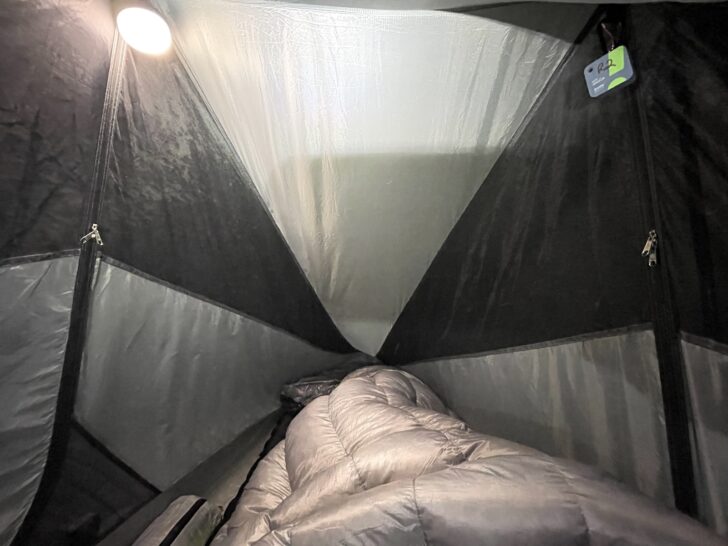The first snows of fall make me happy. I live at 7,500 feet above sea level, and my town is rimmed by mountains that are prettier when they’re snowy. While I appreciate their majestic rock faces, I like them more with a bit of white on them. Even more, I like experiencing early-season snow while hiking and camping in them.

So when the weather forecast started to go south, I started packing.
With a forecast of a few inches of snow, this trip would be my transition out of summer gear and into fall gear.
Gear Notes
Some of the changes I made to my hiking clothes:
- Hiking pants – replaced thin polyester pants with warmer prAna Stretch Zion softshell pant
- Hiking shirt – replaced a thin polyester button-down with a Brynje Super-Thermo Fishnet / Arms of Andes Alpaca combo
- Hiking socks – no light socks anymore, time for Darn Tough Full Cushion Boot Socks
- Hiking shoes – hung up breathable trail runners for La Sportiva Ultra Raptor Wide GTX Mid Boots, oversized two sizes to accommodate extra insulation, leave toes less constricted
- Extra hiking layer – added the Senchi Alpha 60 Hoody
I also hiked in snowy, windy, cold weather, so my hands were tucked away inside Outdoor Research Flurry Sensor Gloves and Outdoor Research Revel Shell Mitts.
In camp, I added Rocky Goretex socks to keep my feet warm after I stopped hiking, a Senchi Alpha 60 Pant layer for a touch of extra insulation, and transitioned to a more insulative parka (my PhD Yukon K Hoody).
I still carried a 20-degree down quilt for sleep, but since I was to sleep on snow, I opted for the NEMO Tensor Extreme Sleeping Pad and added a double-walled tent (Tarptent Notch Li with Solid Inner) for a few extra degrees of indoor temperature.
Other than that, I stuck with the majority of the rest of my summer kit, and it served me well enough. Next time, though (note to self): booties and puffy pants.
Trail Notes
When I left the 8,500-foot trailhead at around noon, it was 45 °F and cloudy. Four hours later at my destination (an alpine lake at 11,000 feet), it was 29 °F and snowing. The trail was dirt up to about 10,000 feet, then patchy snow. As I passed little streamlets here and there with tiny icicles dangling from their rocks, I chuckled a little bit, thinking, “C’mon, it’s not that bad yet.” I’d rethink that sentiment the next morning.

Squirrels were frantically dropping pine cones and building their seed caches as if on a sunset deadline. A chipmunk scurried over my feet, cheeks full, while I was hiking. It tripped over my shoelace and careened off my shin in a slightly different direction than intended.
By early afternoon, the wind started to blow. Five miles an hour, then ten, then fifteen. I layered. First, the fleece hoody. Then, gloves. Then, rain jacket and pants. Then, rain mitts. Then, sunglasses (?) to avoid the stinging of snow in my eyes, in spite of the fact that the skies were darkening.
Camp Notes
My camp was located above the lake and somewhat protected in the trees. However, by late afternoon the temperature had dropped to 21 °F and the wind had picked up, gusting through camp at 20 mph. Wearing all of my clothing, I was starting to shiver, so I retired into my tent.

I crawled under my quilt, brewed coffee, and listened to a podcast. I then napped, awakened here and there by the freight train sound of the wind on the 13,000-foot peaks surrounding my camp. A nearby tree was starting to sing and squeak, its lower trunk weakened by the presence of a 1-inch crack splitting its lower trunk. Fortunately, it was leaning away from me.
After darkness enveloped my camp, I mustered up the courage to exit my tent to cook dinner, not in the mood to spend any more time in the confines of the little tent than I had to. It was snowing harder now, so I set up my chair, hunkered under a light tarp that I’d pitched nearby, and boiled water. I meditated for the 18 minutes or so it took to rehydrate my meal under my parka, trying to will away the occasional shiver. After eating and cleanup, I checked my outside sensor: 17 °F. I retreated back to the tent with a full belly and the fatigue of the day’s elevation gain. Sleep came easy.

Two hours later, I woke up, coughing spectacularly and shivering, and a sense of dread came over me. Chase had the flu this week, and I thought I’d escaped it. But it was just incubating with me during my hike in and didn’t go rogue until the demon virus knew I was trapped in this mylar-and-UHMWPE winter coffin, far from the warmth of my bed back home.
It was a long night. Sleep came in spurts, 20 minutes here, 30 minutes there. Other than the 25-minute break for dinner and two late-night pee breaks, I would spend 16 hours in the tent.
Morning Notes
I woke up for good at around 8 AM. I could see blue sky through the paper-thin walls of my tent, but the wind remained belligerent.

I checked my sensors: 14 °F outside, 17 °F inside my tent. Too many hours spent in a prone position while battling the onset of the flu left my back sore. I had to get out of bed at some point, now seemed like a good time.
I was already fully dressed, so all I had to do was stuff my sort-of-warm feet into my sort-of-cold boots. After relieving myself, expelling the phlegm from my congested sinuses, and making a cup of hot coffee, the wind died. I took my coffee and quilt and walked the few hundred yards to the lakeshore. I found a dry rock, wrapped myself in my blankie, and let the sun and hot drink do its good work for the next half hour.

After eating a hot breakfast hash, I felt a little better, so I continued my work. Some gear testing, analyzing sensor data from the night before, a little writing, and some filming for a new module being presented during our current live online course cohort.
Finally, a little after noon, I packed up, messaged Stephanie with my pickup time and location, and started walking.
I would make it back just in time, virus in tow, and spend the next three days in bed.
Post-Trip Notes
It no longer surprises me how much colder the same temperature feels in October vs. July. A few things are going on here. The temperatures are sustained at colder levels for longer periods of time when days are shorter. The sun is lower, so there’s less radiative heat gain. Winds are stronger and more sustained. I have to remind myself time and again – don’t just pack for the coldest expected temperature – pack for the season. Reminder: booties and puffy pants (slaps head).
The Tarptent Notch Li with its solid inner tent is a fine fringe-season shelter. Its steep sidewalls shed snow well, and its small roof panels don’t really hold much snow before it sloughs off. However, DCF is a “cold” tent fabric (due to radiative heat loss), and the Notch solid inner tent is only partially solid – the upper sidewalls have large mesh windows in it. It’s not a warm combination, at least, not warm like a double wall tent with a polyester or nylon fly and full solid inner tent, which can offer interior temperatures that are 8 to 12 °F warmer than outside. In addition, while the solid inner kept the wind blowing under the fly out of my sleeping area, it did not prevent the ingress of fine spindrift throughout the night, and I found myself covered in a light dusting of snow and frost in the morning.
Cooking on an upright canister stove in breezy conditions (gusts of 5 to 12 mph atop the cut stump that was my cooking table) was fine. My water volumes were small (200 to 500 ml), and I kept my canister in my parka when not in use to keep it warm. I was using an MSR Pocket Rocket Deluxe (with no additional windscreen) and a Vargo Titanium BOT 700.

I knew something was happening in my body before I started to show symptoms. The trail in was a steady, uphill drive (2,500 feet of elevation gain over about 6.5 miles). However, after two hours, something happened to my heart rate. The same grades on the first half of the hike that drove my heart rate into the 130s were driving my heart rate into the 150s during the second half of the hike. I saw this as a red flag, but ignored it, just thinking that the trail was getting steeper (it wasn’t). I didn’t really see the decay in my aerobic performance until I analyzed the data after my trip. In retrospect, I wished I had performed a heart rate variability (HRV) test the morning that I’d left. Almost without exception, I can predict the onset of sickness with an HRV test.

Related Content:
- Author: Read more by Ryan Jordan!
- Podcast: Episode 89 | Fall Layering Systems
- Trailhead: As winter begins its arrival in the mountains, be prepared by checking out our Winter Backpacking Trailhead
- Member Trip Reports: Read about another fall backpacking trip in Rocky Mountain National Park.




Home › Forums › Field Notes: Careening into Winter